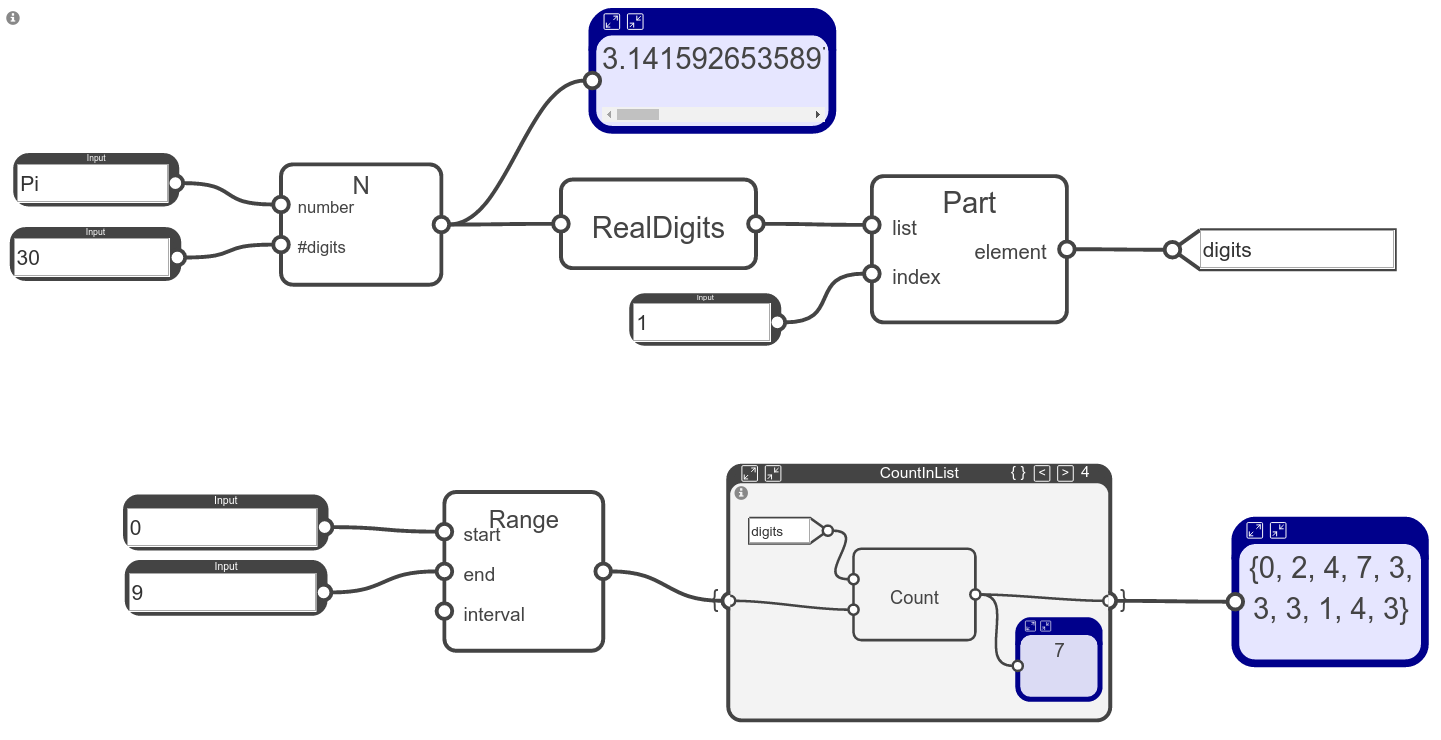Website: https://visx.io/
Announcement video: https://youtu.be/Ulz96RZXHAY
Beta version call: https://community.wolfram.com/groups/-/m/t/2713297
Hi everyone.
I'm working on a visual interface to the Wolfram Language called visX, and I'd like to ask what you all think of it.
Wolfram Language code can often be thought of as a set of blocks, each of which takes some inputs, does something, and produces an output. VisX lets you write WL code exactly this way - you draw a digram, connecting blocks with links. For example, say you want to count how many times each digit (0 to 9) occurs in the first 30 digits of Pi. With text-based WL code, you'd write
digits = RealDigits[N[Pi, 30]][[1]]
Count[digits, #] & /@ Range[0, 9]
In visX, you'd draw this:

I guess it's pretty self-explanatory. In addition to using built-in WL blocks, you can write your own, like the CountInList block. Normally, blocks just transform inputs to output, but the CountInList block is mapped over its input which is indicated by the little brackets on the outside of its connection ports. (That's basically visual syntactic sugar for "/@" or Map.) The 4 in the upper-right corner indicates that results inside this block are showing results from the 4-th time through the map. The block with "digits" in it sets a variable, which is then referenced in the CountInList block.
You define blocks (which are basically functions) by just making an empty rectangle and dragging contents in then wiring them together, then you can use copies of the block wherever you want. A change in any copy of the block will be reflected in all other copies. There's no real difference between a defining a block and using it. Recursion can be specified by just including a copy of the block inside itself. Blocks can call other blocks in the same manner.
Just like regular WL code, visX blocks can be nested deeply, but with the visual interface, it's easy to zoom in and out. At any point, the UI will show you the right amount of detail for each block - sometimes no detail at all, sometimes its name and labels on its inputs, sometimes its actual contents (which can then be edited or further zoomed...).
visX is stand-alone software that runs locally on your machine, evaluates the diagram using your local Mathematica kernel, and receives the results and puts them back in the diagram. You can load data files using Import as usual.
One of the problems that I've seen with visual languages in the past is that while simple things are easy to do, the code quickly gets too complex to manage and the visual interface starts to get in the way. With the Wolfram Language in theory everything is an expression, and this can lead you to write functional-style programs which are easily thought of as a diagram, but that's not always the most natural way to express a computation. Sometimes you just need a little for loop. Consider calculating Fibonacci numbers. Start the sequence with 1, 1, ... then each element of the sequence is the sum of the previous two. Yes, you can write a recursive algorithm to do this, but most people just want to write a little for loop. In visX, you can do this (calculates the 6th Fibonacci number):

I've tried to let you use blocks-and-links when that's the most natural thing (which is usually), and text-based code when that's better. Of course, you can mix them together however you want.
A second problem I've found with visual programming languages is that it can actually be much slower to use then writing out text, because you have to laboriously drag and drop every single block. Even simple algebraic expressions like
Sin[x]^2 + Cos[x]^2
2x^2 + 4x*y + 8y^2
would involve a lot of blocks because of all the Plus, Times, and Power blocks, as well as all the constants and symbols. With visX, you can enter Wolfram Language code snippets like those, and it will parse them and transform them into blocks which you can then insert into your diagram all at once and edit at will. This makes it much faster to get your idea onto the screen so that you can start evaluating it and developing it. I'm also working on the ability to take a visX block and give you back the Wolfram Language code that it represents.
The examples given here are simple, but of course you can use this interface for putting together a complex piece of code as well. I find it especially handy when building up a calculation with lots of intermediate results along the way, or to rapidly prototype an algorithm where I want to be able to easily switch the data flows around.
Does this project seem useful to anyone? I'd like to get some feedback - what do you think of it? Would you use it? For what?
If there's interest, I could do a small-scale alpha test in about a month from now.
More info at visx.io.
-Nicholas Hoff
edited to clarify block definitions and recursion